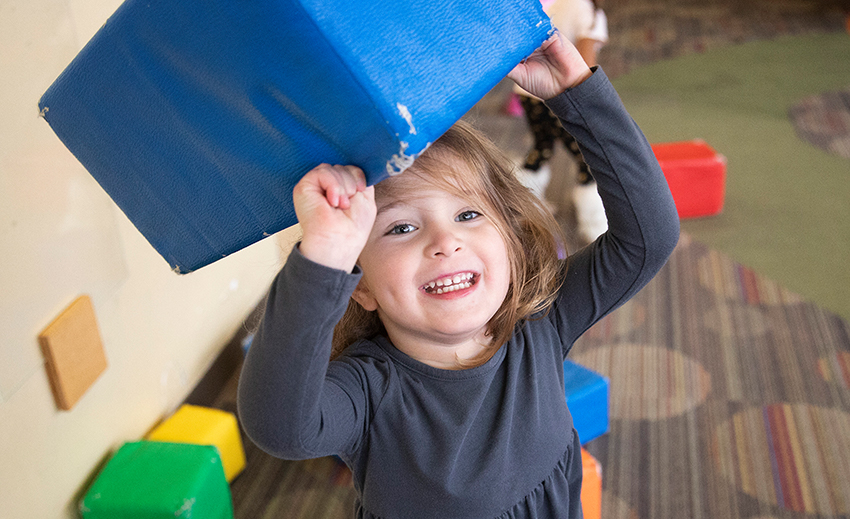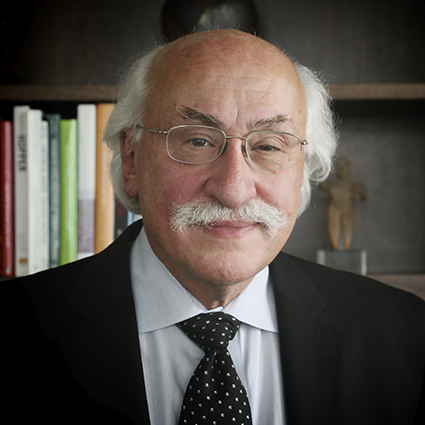 Ten new guidelines for reopening child care released by Buffett Institute leaders attempt to lower the health risk as much as possible while meeting the behavioral and developmental needs of young students.
Ten new guidelines for reopening child care released by Buffett Institute leaders attempt to lower the health risk as much as possible while meeting the behavioral and developmental needs of young students.
By Matthew Hansen, Managing Editor
He imagines a group of young children playing with their new toys in the house area. A boy pinballs in, grabs a mask off a hook and struggles to place it on a doll. Then the girl pulls the mask off and fumbles to put in on herself. Then two other children loudly direct each other on how to take a doll’s temperature using a toy thermometer.
Surgical masks aren’t the normal toys that Sam Meisels, founding executive director of the Buffett Early Childhood Institute, hopes that young children use to play. But they are exactly the toys young children need right now, Meisels says. In fact, “dramatic play” featuring thermometers, masks, and other personal protective equipment is one of 10 new guidelines released by Buffett Institute leaders to help Nebraska child care providers safely and effectively operate during the COVID-19 pandemic.
“When a child play-acts, when he or she dramatizes some event, the child takes control over it,” says Meisels, a world-renowned early childhood expert. “It reduces the fear of the unknown.”
The unknown is exactly what adults and children alike are plunging into as we attempt to return to some semblance of normal after a spring during which schools and many child care providers closed. It won’t be easy. The virus is still circulating. Schools are planning for the fall, a tall task since no one knows what the coming months will bring.
Every activity, particularly in hard-hit areas like Columbus, Grand Island, Lexington, Omaha, and South Sioux City, causes many of us to weigh the risks and rewards of doing things we once viewed as routine. We wonder: Am I safe to go to the hardware store in a mask? Should I hang out in a backyard with friends?
And, a huge one for parents: Should I send my children back to child care?
The Buffett Institute guidelines, which you can read here, attempt to lower the risk as much as possible for parents, children, and providers while acknowledging that the risk cannot be escaped. They also try to preserve the rewards of things like group play or recess, balancing health concerns with the behavioral and developmental needs of young students.
 Sam Meisels
Sam MeiselsIn short, the guidelines try to keep everyone safe while also giving children what they need.
“Essentially the task here is, how can you recommend that children go about as normal a life as possible while being as safe as possible from a lurking infection nobody can see?” Meisels says. “That isn’t easy.”
Children with no underlying health conditions can go to child care if their parents deem the risk acceptable, according to state leaders.
But if they do, Meisels and other Institute experts suggest they should do so in a classroom of 10 or fewer children. (The current state limit is 15 children per classroom. Institute experts prefer 10 for safety and developmental reasons.)
Yes, there should be recess—children need to run and play—but that recess should happen only with that same group of 10 or fewer children. Smaller groups keep everyone safer. An adult should clean the equipment between each group use.
Yes, there should be meals, but they should be served carefully by an adult, not family style. Yes, children should play together, but that play should involve masks and thermometers, or helping with a new, rigorous classroom cleaning routine.
“We are trying to capture all the features that will make the return to school or the reopening of child care as comfortable, as safe and as emotionally secure as we can make it,” Meisels says.
The guidelines stress open communication between providers and parents, and providers and children.
Ideally, a child’s caregiver and a child care provider should talk by phone before the child comes back to child care. The provider needs to know: Does the child know anyone who has gotten sick? How much does the child know about what is going on? What is the child’s anxiety level?
This initial conversation should be followed by daily check-ins, maybe at pickup or drop-off.
In the event of a positive case, the child care provider should immediately notify local public health officials and all parents. “This isn’t the sniffles,” Meisels says.
The lower staff-to-child ratio, the better right now, Meisels says. Children are living through a traumatic event and need more personal attention.
Providers also need to reassure children. Meisels, a one-time Kindergarten teacher, imagines kneeling in front of a child and pulling his mask down so the child can momentarily see his face. He imagines briefly explaining why he’s wearing a mask—to try to make sure no one gets sick—while making sure the children recognize that underneath that mask is the same trusted adult.
Says Meisels: “We have to show children what hasn’t changed in addition to what has changed.”
Matthew Hansen, the managing editor of the Buffett Early Childhood Institute at the University of Nebraska, is an award-winning journalist tasked with telling the stories of the Institute's work and early childhood care and education in Nebraska and beyond.
His columns can be read at https://buffettinstitute.nebraska.edu/news-and-events/early-years-matter.